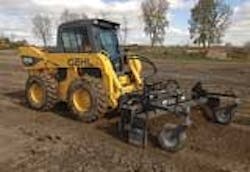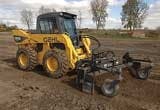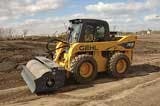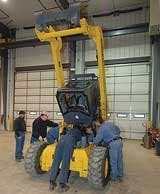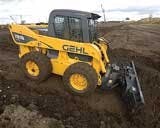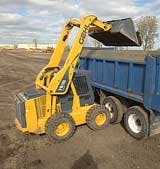The Gehl 7810E Skid-Steer Loader has the Power to Handle Large Attachments
When Gehl delivered a new 7810E skid-steer loader to the Apprenticeship and Skill Improvement facility that Local 150 (International Union of Operating Engineers) maintains in Plainfield, Ill., we weren't surprised to hear the Local 150 instructor crew call it names. But in this instance, "horse," "beast" and "grizzly bear" were compliments.
Based on the machine's rated operating capacity of 3,850 pounds, the 7810E is the largest skid-steer around (except, of course, for its twin in the Mustang line, the model 2109). We thought this size distinction made the machine an interesting candidate for a Hands-On-Earthmoving evaluation.
Gehl's Kelly Moore, product manager for skid-steer and compact track loaders, and Lori Heidecker, marketing services manager, arranged the loan of the 7810E. The machine arrived nicely equipped — with joystick controls, HydraGlide ride-control system (standard with the joysticks), two-speed-travel system, Titan H/E severe-duty tires, and an electrically actuated Power-A-Tach coupler.
About the only option the 7810E didn't have was high-flow hydraulics (rated at 41 gpm). But with a standard auxiliary flow of up to 29 gpm, the machine had more than enough hydraulic horsepower to handle the work tools that accompanied it. The 7810E arrived with a 90-inch power rake, an 84-inch vibratory roller, an 8-foot dozer blade (with powered angle and tilt functions) and its big 1-cubic-yard bucket. All these tools were EDGE brand products supplied by CEAttachments, and CEAttachments' sales supervisor, Ron Peters, was on site to help with installation.
Our introduction to Gehl's 7000-Series models actually goes back to late 2001, when CE conducted a field comparison between the then-new 7800 (with a rated operating capacity of 3,600 pounds) and the 6635DXT, which, with a standard rated operating capacity of 2,350 pounds, had previously been the largest model in the Gehl line. The big jump in capacity, explained Moore at the time, was to meet the demand of customers who needed a larger machine for handling taller trucks and heavier attachments.
In the intervening years, says Moore, the big machine's market acceptance has exceeded Gehl's expectations.
"It's a powerful machine," says Moore, "and when properly applied, it excels in a variety of applications. We also consider it a viable replacement for certain compact wheel loaders, especially if maneuverability, cycle speed and attachment performance are important. And, it's considerably less expensive than wheel loaders having similar horsepower, capacity and lift height."
The recently introduced 7810E, compared with its 7800 predecessor, has gained some weight, now tipping the scale at 10,520 pounds. The weight gain, resulting principally from frame changes and from structural changes in the lift arm, gives the new model 250 pounds more rated operating capacity and significantly more bucket breakout force — now rated at 8,340 pounds.
The engine also has been changed. But in a bit of a turnaround from the typical practice of increasing power in new models, the 7810E actually has 15 less horsepower than its predecessor. The new 99-hp Cummins B4.5T-99C, however, has nearly 5 percent more torque (305 pounds-feet) than the previously used Perkins and, according to Moore, you won't notice any performance differences — and might see a modest improvement in fuel economy. Customers were asking for Cummins power, says Moore, and the chosen engine allowed the 7810E to delay Tier-3 emissions regulations and the related design complexity that compliance would have entailed (such as charge-air cooling).
Retained from the predecessor model, though, is a long list of features, including the 55-inch wheelbase, lift height of 142 inches (at the bucket hinge pin), vertical-path PowerView lift arm, large Rexroth servo transmission, and radial-piston drive motors.
The first stop for the 7810E was the Local 150 shop, where Moore, Heidecker and Peters reviewed the features of the machine and its work tools for the Local's technical staff. Basically, all agreed that the 7810E was an impressive machine, but since not much in the way of design detail gets past this experienced crew, they had a few observations.
For example, after seeing the heavyweight attachments that the 7810E was to use, Rick Bewsey questioned the capability of the machine's universal-style coupler, wondering if it had the mass and strength to handle these large tools. Moore assured him that the coupler had been sized appropriately, and that both testing and field use on the 7810E's predecessor had proved it capable of accommodating any approved attachment.
Dale Brown made an observation about the 7810E's fuel filler. The machine's light-colored, polyethylene fuel tank has an extended-neck filler tube that's sealed with a black cap. The filler tube is adjacent to the radiator, and is identified only by a small decal on the inside of the frame.
"The fuel-tank filler should be more clearly identified — with a conventional green cap and with unmistakable identification on the tank," said Brown. "Our perspective as trainers is dealing with inexperienced operators and technicians, and if they see a filler tube next to a radiator, like this one, then it may get antifreeze and not fuel. Believe me, we've lived through this."
(NOTE: Gehl changed to a green cap with mid-October production.)
Tom Barone suggested that the hydraulic filler tube, located near the top of the engine, be raised to avoid spilling when replenishing fluid. He also questioned the location and accessibility of the batteries, which are in a compartment beneath the operator's feet. Moore explained that an exterior panel allows access to the batteries, and that remote terminals at the rear of the machine can be used for jump-starting or to power electrical accessories, such as a refueling pump.
Tom Rush, our operator for the day, suggested the electrical cable, which powers the coupler, could be better protected.
"Good suggestion," said Moore, "but we've beaten you to it — it's already in engineering."
This crew, however, is equally ready to point out what they see as positive design elements. Bewsey thought that the absence of a computer and the use of a mechanical fuel system made for a sensible design in a skid-steer.
"I'm not anti-technology," he said, "but if you don't need electronics, then don't use them. Sometimes this electronic stuff is just bells and whistles that add cost and complexity."
And Brown, who spends his share of time bending wrenches, was pleased to see that the 7810E's chain-case covers provided generous openings for service. "That's a sore point on some skid-steers," he said.
Bewsey essentially summed up the group's consensus: "It's a horse; I'm impressed."
Having had a close look at the 7810E in the shop, operator Tom Rush was interested in getting the machine into the dirt. His first experiment was to dig from a firmly compacted stockpile of wet soil, maneuver a bit with the loaded bucket, then dump from full height.
"The machine's capacity is incredible," said Rush. "This is really heavy stuff, and it had no problem breaking it out and lifting it. I've seen the back end of some small wheel loaders come up working in this material. I'm also impressed that the machine is so stable with such a large bucket. Just as a little test, I got the bucket as full as I could, raised it and shook it a bit. But the machine didn't flinch."
Rush was able to add a real-world aspect to the load-and-dump exercise when we flagged down Local 150's newest tandem-axle dump truck, measuring 9 feet to the top of the sideboard. After making a few passes, Rush was again complimentary about the machine's capabilities.
"The machine's lift height is great. The boom seemed to keep going up and up. I could almost dump in the center of the truck. I could see a concrete contractor using it for lifting forms onto a truck with a set of forks — and for moving a lot of stone for base or backfill."
Rush next used the dozer blade, which, as noted, was 8 feet wide with hydraulic angle (30 degrees) and hydraulic tilt (10 degrees) — right and left for both functions. The blade was 24 inches tall, weighed slightly more than 1,500 pounds, and was, as technician Rick Bewsey observed, "a very stout piece of hardware."
According to CEAttachments' Ron Peters, the blade is primarily designed for leveling, grading and piling loose material. But since it had rained the night before, wet, heavy soil was about all Rush had to push. The 7810E's severe-duty tires, Moore told us, really weren't the optimum choice for working in mud, because they don't throw off sticky material as well as conventional HD lug-style tires. Dozing in the wet soil, he said, would have been easier with over-tire tracks. But, that said, Rush thought the 7810E did an acceptable job.
"The blade worked better in the mud than I would have thought, and even though the tires were packing, the machine still pushed aggressively at slow speeds. If you were grading on hard ground, the machine's long wheelbase would be valuable, because it lets you actually feel the dips and rises a little better. The only criticism I have is that it's difficult to see the corners of the blade when it's angled, so it's difficult to keep the windrow going — and I had a problem with depth control."
Moore explained to us that the blade works best when the machine's boom arm is firmly against its stops, allowing a solid connection through the coupler to the blade. So, instead of using the boom arm to control blade height, he suggested using the loader mechanism's tilt function, which works well, he said, when the operator becomes familiar with it.
Rush was again complimentary about the machine's performance with the power rake, which he used in relatively dry material uncovered in the dozing exercise. The rake employs dual hydraulic motors to drive the carbide-toothed drum, which angles 20 degrees in each direction to allow windrowing rock. With its end plates installed, the attachment becomes a powered box-rake.
"You could almost use this as a profiler," said Rush. "The stuff I was working in sometimes has to be ripped with a grader to get it loose. But you could make four or five passes with the rake and chew it up pretty good."
In a final exercise with the 7810E, Rush ran the 84-inch, 2,300-pound EDGE vibratory roller over the material just loosened with the rake. The drum's maximum exciter speed is 3,000 rpm, and the vibratory system can work with a wide range of flows (10 to 50 gpm) and pressures (1,500 to 3,000 psi).
"The roller and the big machine make an impressive package," said Rush. "It would be ideal for, say, parking lots, where a contractor might not be able to efficiently use a larger compactor."
When we asked Rush for any final thoughts, the 7810E's overall power was obviously his lasting impression:
"It's like a grizzly bear; I've never seen a skid-steer this strong."
